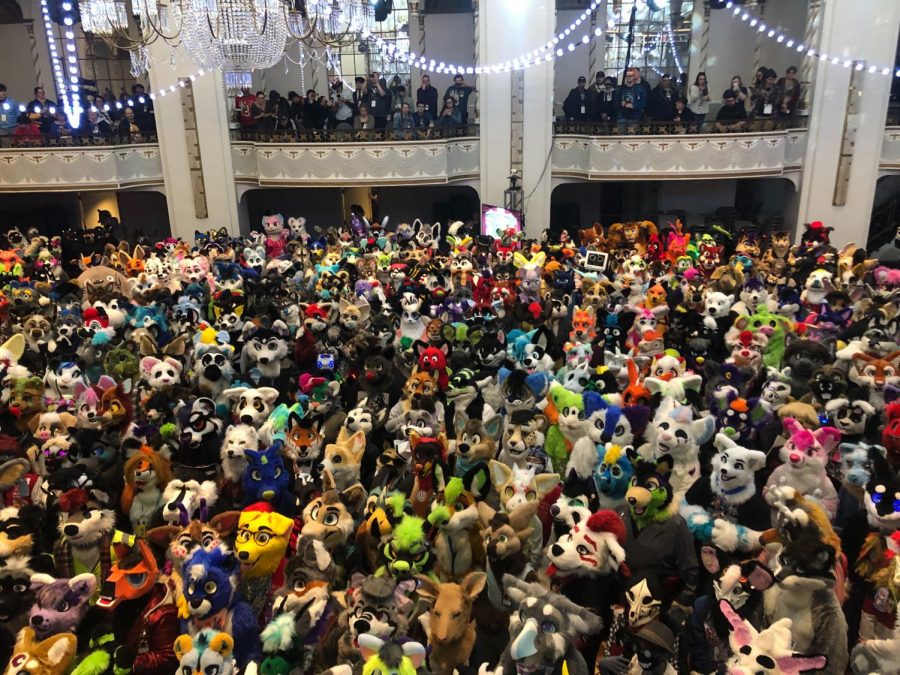Anthro New England convention links furries to LGBTQ+ community
Anthrocon convention drew lots of “fursonas.”
February 27, 2020
Luca the Fox, who is green with massive serrated ears and an unmissable rainbow tail was just one of the over 2,500 furries in attendance at Boston’s Anthro New England convention, or ANE, at Boston Park Plaza this past weekend.
The furry community is a subculture that enjoys anything from drawing “fursonas,” which are anthropomorphized versions of themselves, to dressing up in “fursuits,” which are best described as part art-piece, part mascot costume and are often worth thousands of dollars.
While the link between furries and members of the LGBTQ+ community might not be immediately clear, furries see it as one of the defining features of their fandom and speak about the two communities’ convergence with pride.
The fandom, which congregates online and at conventions globally, has become a haven for members of the LGBTQ+ community. In a 2012 study by Dr. Courtney “Nuka” Plante who specializes in “furscience,” it was determined that less than 30% of furries considered themselves exclusively heterosexual.
“I feel like most people in furry are LGBT at this point,” said Boobun, one of the convention’s honored guests who has been a furry for 25 years. “It’s incredibly connected just because furry is so welcoming. So if you’re not welcome at home because you are a woman who loves a woman or a man who loves a man, or you’re trans or whatever you are, furry will take you.”
Boobun is a well-known artist of anthropomorphic art. This type of art features animals who have been given human-like characteristics, such as the ability to walk on their hind legs.
Rumors of furries working at NASA, Amazon and Google have circulated within the community, but some members, like Adler the Eagle, have made being a furry their full-time job. Adler is an animator and artist with over 30,000 YouTube subscribers who describes his fursona as “a little more positive, a little more outgoing and bubbly than myself.”
As a method of expression, furries often make their fursonas idealized versions of themselves.
“Furry is, for a lot of people, a way to be more comfortable with themselves because you can start with it being a character,” Adler said.
The promotional lead for ANE, Camille Lee-Fitzgerald, is a non-binary drag queen and was a panelist at the convention who credits the community with introducing them to the concept of non-binary gender identities.
“The furry community was … a place that said there’s no judgment here,” Lee-Fitzgerald said. “…I was able to learn more about myself, learn more about what I found attractive and even started, very recently, questioning gender as a whole.”
Lee-Fitzgerald held a panel at the convention on drag makeup, with an audience from all parts of the gender spectrum, some in fursuits and others in clothing adorned with furry art.
Many of ANE’s events, like the three panels for transgender furries and another titled “Culture by Accident: History of LGBT in the Furry Fandom,” demonstrated the interconnected relationship of the two communities.
One director of ANE, Gale Frostbane, whose fursona is a multicolored sabertooth tiger, spoke about the connection between the two communities dating back to the ‘80s.
“Because a lot of people just didn’t talk about their sexuality back then…it became a beautiful safe harbor for people that also were questioning their own gender identity, their own sexuality,” Frostbane said. “…It gave them a place to go.”
The furry community has been consistently misrepresented in the media as a fetish community, rather than what it is: an outlet for expression. Often, furries find themselves defending their community and trying to prove that the sexual aspect is not more present than it is in any other community.
“There are people who think that furries are weird or dumb or lame or creepy. Those people are just wrong,” said Frostbane, a furry celebrity and the proud owner of seven fursuits. “A lot of time they’re just uneducated, they don’t know really what they’re talking about and a lot of times in society if we don’t understand something, we immediately think that it’s wrong or bad or dumb instead of taking the time to understand.”
Members of the community won’t deny that there is a sexual component, and it was prevalent at ANE. Many of the artists selling their wares at the convention had books of artwork labeled 18+, but that’s expected within the convention circuit.
When asked about the effects of the sexual stigma, Lee-Fitzgerald said, “Any possible downside is outweighed by the overwhelming positivity and collective acceptance that this community represents. This is a safe space to explore yourself and be yourself in ways that a lot of other parts of society hold you back from.”
Despite the media’s attempts to paint furries as sex-driven, acceptance, equality, and love are the messages that reign supreme.


















